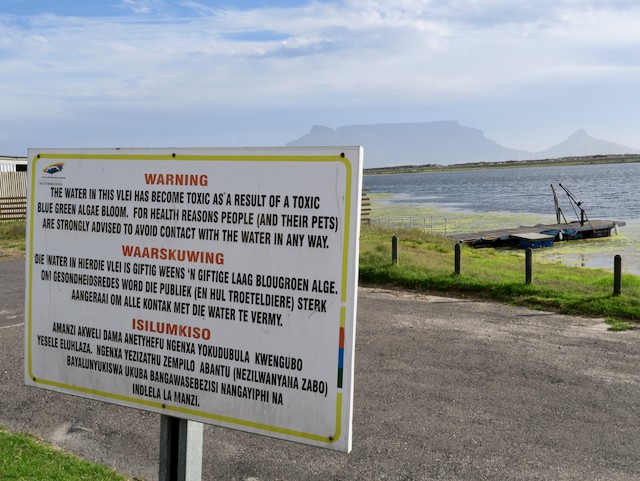
23 November 2021
A sign at Rietvlei warning people not to make contact with the water. Archive photo: Steve Kretzmann
Cape Town’s major public recreational water bodies have been closed for months during the past year because of sewage pollution. The City blames ageing infrastructure, vandalism and theft at its pump stations, and the dumping of foreign objects into the sewers.
But an inadequate drainage system that cannot cope with the wastewater flowing from treatment works, stormwater drains and informal settlements is the main cause, according to Jo Barnes, a public health professor at Stellenbosch University’s Faculty of Medicine and Health Sciences.
Zeekoevlei has been closed since July this year. Zandvlei, closed since May, briefly opened again for two weeks in October before closing again. Rietvlei opened again on 17 November for intermediate recreational use since it closed in June. Similarly, the Milnerton lagoon and Diep River have experienced persistent pollution issues for years.
The pollution at these waterbodies is the “knock-on effect of a poorly functioning system” said Barnes.
Water quality test results conducted by the City showed frequent and dangerously high levels of E. coli in the waterbodies. A petition with nearly 15,000 signatures has called on the City to urgently address the sewage spills at Zandvlei.
The pollution problem at the three vleis grabs the headlines because of the “recreational component” says Liz Day, an independent freshwater ecologist who put together the latest Inland Water Quality report for the City, released in February.
“In fact, throughout the City there are large areas where there is just free-flowing sewage, either flowing into the sea or flowing into the streets or into the canals,” says Day.
In a statement in September this year the Ciy said, “Over the next three years, almost 50% of the City’s R25-billion capital expenditure plan will be invested in water and sanitation infrastructure. The City is further projecting a minimum R8-billion investment for major Waste Water Treatment Works (WWTWs) upgrades over the next ten years.”
This will incresse capacity at the Zandvliet, Potsdam, and Macassar wastewater treatment works.
The City said in August this year that R60 million was needed for repairs and upgrades at its 32 pump stations because of vandalism during the last financial year.
Day thinks there needs to be more urgency in the repairing and maintaining of treatment works and pump stations, because of the long-term effects on the ecology of the vleis. Sewage pollution increases nutrients in the water promoting weed growth, algae blooms, and the spread of water hyacinth, which is an invasive species. The sewage acts as “a large volume of fertilizer”.
“It’s not acceptable for sewage … to simply pass into open water canals and rivers, and ultimately vleis and then the sea,” said Day.
The City said that failures at pump stations at Zandvlei, which caused some of the sewage spills this year, were caused by solid and foreign objects being dumped in the sewer lines.
But Barnes points out that many people living in informal settlements dump things because they don’t have proper or reliable solid waste removal facilities. The stormwater system in most of our informal settlements operates as a second sewer system, primarily because people who live there have inadequate access to sanitation facilities.
“Blaming the behaviour of people when they have inadequate facilities is unfair and it does nothing to solve the problem,” said Barnes.
Population growth over the past few years has outstripped the City’s capacity for waste removal and sanitation.
The City has said that it is taking various remedial actions to address the pollution in the three vleis and that it continues to investigate all the sources of pollution.
The City said that currently it was helping the ecological functioning of Zandvlei by removing pondweed and algae, manipulating the mouth to allow sea water to flow in, and also dredging to flush the vlei.
A dredging programme was being considered for Zeekoevlei and Rietvlei too. Pondweed and algal removal was being done at Rietvlei.